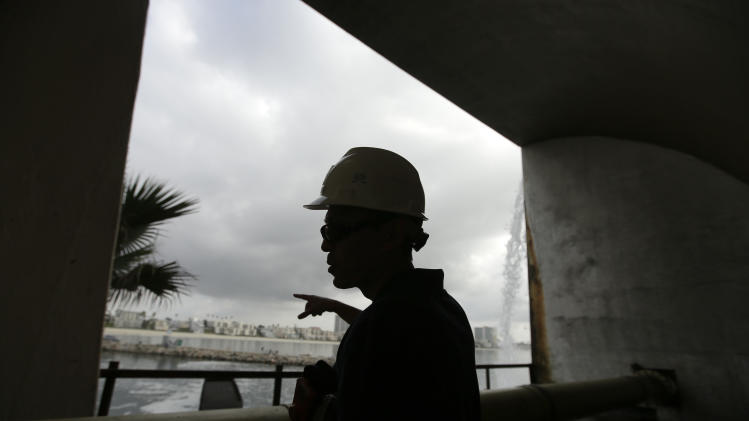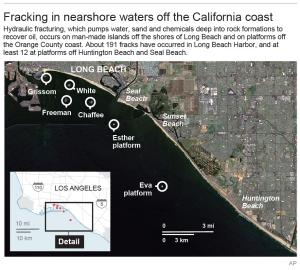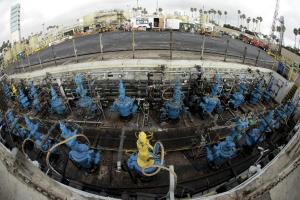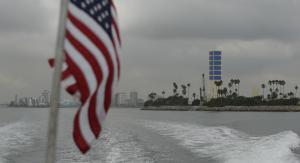Results 1 to 1 of 1
Thread Information
Users Browsing this Thread
There are currently 1 users browsing this thread. (0 members and 1 guests)
-
10-19-2013, 03:51 PM #1
Calif. finds more instances of offshore fracking
Calif. finds more instances of offshore fracking
 By ALICIA CHANG and JASON DEAREN2 hours ago
By ALICIA CHANG and JASON DEAREN2 hours ago

View gallery

.
.
.
LONG BEACH, Calif. (AP) The oil production technique known as fracking is more widespread and frequently used in the offshore platforms and man-made islands near some of California's most populous and famous coastal communities than state officials believed.
In waters off Long Beach, Seal Beach and Huntington Beach some of the region's most popular surfing strands and tourist attractions oil companies have used fracking at least 203 times at six sites in the past two decades, according to interviews and drilling records obtained by The Associated Press through a public records request.
Just this year in Long Beach Harbor, the nation's second-largest container port, an oil company with exclusive rights to drill there completed five fracks on palm tree-lined, man-made islands. Other companies fracked more than a dozen times from old oil platforms off Huntington Beach and Seal Beach over the past five years.
Though there is no evidence offshore hydraulic fracturing has led to any spills or chemical leaks, the practice occurs with little state or federal oversight of the operations.
The state agency that leases lands and waters to oil companies said officials found new instances of fracking after searching records as part of a review after the AP reported this summer about fracking in federal waters off California, an area from three miles to 200 miles offshore. The state oil permitting agency said it doesn't track fracking.
View gallery."

Map shows fracking sites off the California coast; 2c x 4 inches; 96.3 mm x 101 mm;
As the state continues its investigation into the extent of fracking both in federal waters and closer to shore and develops ways to increase oversight under a law that takes effect in 2015, environmental groups are calling for a moratorium on the practice.
"How is it that nobody in state government knew anything about this? It's a huge institutional failure," said Kassie Siegel, an attorney with the Center for Biological Diversity. "Offshore fracking is far more common than anyone realized."
Little is known about the effects on the marine environment of fracking, which shoots water, sand and chemicals at high pressure to clear old wells or crack rock formations to free oil. Yet neither state nor federal environmental regulators have had any role in overseeing the practice as it increased to revitalize old wells.
New oil leases off the state's shores have been prohibited since a 1969 oil platform blowout off Santa Barbara, which fouled miles of coastline and gave rise to the modern environmental movement. With no room for physical expansion, oil companies instead have turned to fracking to keep the oil flowing.
The state launched an investigation into the extent of offshore fracking after the AP report in August. California officials initially said at the time there was no record of fracking in the nearshore waters it oversees. Now, as the State Lands Commission and other agencies review records and find more instances of fracking, officials are confused over who exactly is in charge of ensuring the technique is monitored and performed safely.
View gallery."

Workers walk near near the oil pumps on one of the four artificial THUMS islands in San Pedro Bay of
"We still need to sort out what authority, if any, we have over fracking operations in state waters; it's very complicated," said Alison Dettmer, a deputy director of the California Coastal Commission.
Nowhere is the fracking more concentrated than in Long Beach, an oil town with a half-million residents and tourist draws such as the Queen Mary.
The city's oil arrangement stems from a deal drawn up in 1911, when California granted the tidelands and other water-covered areas to the city as it developed its harbor. When oil was discovered in the 1930s, the money started coming in.
Long Beach transferred $352 million of $581 million in profits to state coffers in fiscal year 2013 from onshore and offshore operations, according to the city's Gas and Oil Department. Most of the oil recovery comes from traditional drilling while fracking accounts for about 10 percent of the work.
The department says fracking is safe. It has a spill contingency plan and monitors pipelines. Well construction designs are approved by state oil regulators. The designs can be used for conventional drilling and fracking. And the oil industry says offshore fracks are much smaller operations than onshore jobs, involving only a fraction of the chemicals and water used on land.
View gallery."

Workers walk near near the oil pumps on one of the four artificial THUMS islands in San Pedro Bay of
City oil officials see themselves as partners with Occidental Petroleum Corp. not regulators though officials participate in the company's internal audits and technical reviews by the state.
Occidental and the city briefly took a fracking timeout after passage of the state's new rules. Long Beach oil operations manager Kevin Tougas said there are plans to frack again later this year. Occidental spokeswoman Susie Geiger said in an email that the company doesn't discuss its operations due to "competitive and proprietary reasons."
No one is tracking the amounts or precise composition of any fracking chemicals that enter the marine environment, though in September the state passed a law that starting in 2015 would require disclosure of agents used during the procedures.
Fracking fluids can be made up of hundreds of chemicals some known and others not since they are protected as trade secrets. Some of these chemicals are toxic to fish larvae and crustaceans, bottom dwellers most at risk from drilling activities, according to government health disclosure documents.
Myriad state agencies that oversee drilling, water quality and the ocean said they did no monitoring of fracking chemicals during offshore jobs.
View gallery."

A ferry leaves one of the four artificial THUMS islands in San Pedro Bay off the coast of Long Beach
Don Drysdale, a spokesman for the California Department of Oil, Gas and Geothermal Resources, said the new regulations will include "extensive protections" for groundwater.
The industry estimates that about half of the fluids used during fracking remain in the environment; environmentalists say it is much higher. Long Beach says it uses a closed system and there's no discharge into the water. Instead, fluids are treated before being re-injected deep under the seafloor.
The Long Beach Water Department, which monitors well water quality annually, said there are no known impacts to residents' water from fracking.
"It's our hometown," said Chris Garner, a fourth-generation resident who heads the gas and oil department. "We have a vested interest in making sure the oil operations have been without harm to the city."
http://news.yahoo.com/calif-finds-mo...143736246.html
NO AMNESTY
Don't reward the criminal actions of millions of illegal aliens by giving them citizenship.
Sign in and post comments here.
Please support our fight against illegal immigration by joining ALIPAC's email alerts here https://eepurl.com/cktGTn


 LinkBack URL
LinkBack URL About LinkBacks
About LinkBacks




 Reply With Quote
Reply With Quote


As Sen. Cortez Masto Scuttles Mayorkas' Impeachment, Illegal...
04-18-2024, 06:27 AM in Americans Killed By illegal immigrants / illegals